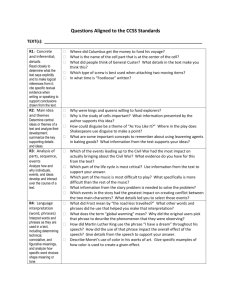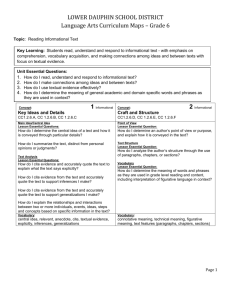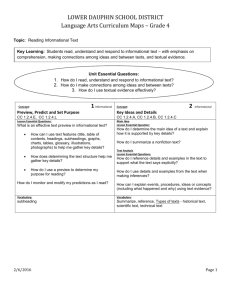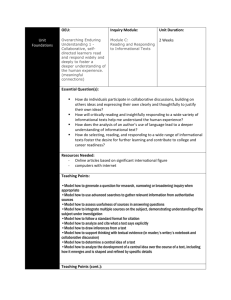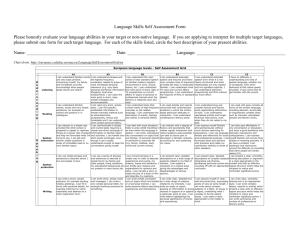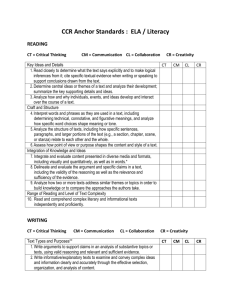Standard Knowledge Reasoning Performance Skill Product RI 1
advertisement
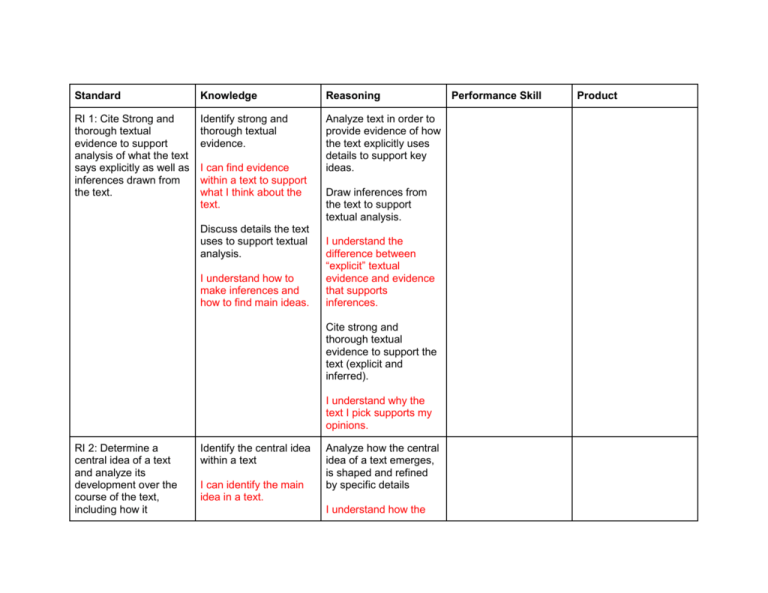
Standard Knowledge Reasoning RI 1: Cite Strong and thorough textual evidence to support analysis of what the text says explicitly as well as inferences drawn from the text. Identify strong and thorough textual evidence. Analyze text in order to provide evidence of how the text explicitly uses details to support key ideas. I can find evidence within a text to support what I think about the text. Discuss details the text uses to support textual analysis. I understand how to make inferences and how to find main ideas. Draw inferences from the text to support textual analysis. I understand the difference between “explicit” textual evidence and evidence that supports inferences. Cite strong and thorough textual evidence to support the text (explicit and inferred). I understand why the text I pick supports my opinions. RI 2: Determine a central idea of a text and analyze its development over the course of the text, including how it Identify the central idea within a text I can identify the main idea in a text. Analyze how the central idea of a text emerges, is shaped and refined by specific details I understand how the Performance Skill Product emerges and is shaped and refined by specific details; provide an objective summary of the text. Identify specific details that support the development of the central idea as it: ● emerges ● is shaped ● is refined I can find details to support the main idea as it is developed through the text. Provide an objective summary I can summarize the text I read. author develops a main idea throughout the text. Interpret how the text supports key ideas with specific details I understand how specific details are used to support the main idea. Formulate an objective summary that includes how the central idea emerges, is shaped and refined by specific details. I can provide a summary of the text that includes the man idea ad the details to support it. RI 3: Analyze how the author unfolds an analysis or series of ideas or events, including the order in which the points are made, how they are introduced and developed, and the connections that are drawn between them. Identify organizational patterns (e.g., cause/effect, chronological, sequential, order of importance, c/c and logical) Identify paragraph development strategies Determine the main ideas or events I can identify main ideas and events and examine how author developed these ideas. Examine the strategies the author uses to ● introduce his (e.g., facts, statistics, examples, anecdotes) I can identify organizational patterns and paragraph development i a text. ● points develop his points Analyze the author’s use of organizational patterns and techniques to connect ideas and communicate an overall message I can analyze how an author uses different organizational strategies to develop ideas to convey a message within a text. RI 4: Determine the Identify: meaning of words and ● words and phrases as they are phrases used in a text, including ● figurative words figurative, connotatve, and phrases and technical meanings; ● connotative analyze the cumulative words an impact of specific word phrases choices on meaning and ● technical words tone (e.g. how the and phrases language of a court in a text opinion differs from that of a nwspaper). Identify tone of a text I can identify important words/phrases, figurative, connotative, and technical Determine the meaning of words and phrases as they are used in a text, including: ● figurative ● connotative ● technical meanings Analyze the cumulative effect of word choices on: ● meaning ● tone I understand the meaning of these different types of words RI 5: Analyze in detail how an author’s ideas or claims are developed and refined by particular sentences, paragraphs, or larger portions of a text (e.g. a section or chapter). words/phrases in a text. and phrases I understand what tone means and can identify tone in a text. I can analyze the overall effect of these different types of words/phrases on the work a a whole. Identify the author’s ideas or claims Analyze how the author uses particular: ● sentences, ● paragraphs, or ● larger portions to develop or refine: ● ideas or ● claims I can identify the author’s ideas or claims. Determine the structure/text features of an informational passage I can break down the parts (introduction, body, conclusion) of an informational passage. RI 6: Determine an author’s point of view or purpose in a text and analyze how an author uses rhetoric to advance that point of view or purpose. Define rhetoric Identify rhetorical techniques I can define and identify author’s perspective (point of view) I can identify and define rhetoric I can explain how an author develops his ideas or claims using sentences, paragraphs or larger portions of text. Analyze the author’s use of rhetoric I can analyze the author’s use of rhetoric (language). Analyze the rhetorical techniques the author uses to express his/her point of view or purpose I can determine author’s purpose/reason I can analyze the author’s use of rhetoric (language). Support your analysis with examples from the text RI 7: Analyze various accounts of a subject told in different mediums (e.g. a person’s life story in both print and multimedia), determining which details are emphasized in each account. Identify different mediums I know stories can be told in different formats. Recognize details emphasized in various sources I can explain which details are emphasized in various sources. Analyze different accounts of the same subject told in different mediums (e.g., a person’s life story in both print and multimedia) I can explain why different accounts emphasized different details of the account and how it effects its audience. Determine emphasized details in various accounts of a subject told in different mediums RI 8: Delineate and evaluate the argument and specific clams in a text, assessing whether the reasoning is valid and the evidence is relevant and sufficient; Define and identify false statements Define and identify fallacious reasoning Recognize valid Delineate the argument and specific claims in a text Evaluate the argument in a text identify false statements and fallacious reasoning. reasoning Recognize relevant and sufficient evidence I can define and identify false and faulty statements/evidence in a text. I can define and identify true and important statements/evidence within a text. Evaluate the specific claim(s) in a text Assess: ● the validity of reasoning ● the relevance of the evidence ● the sufficiency of the evidence Distinguish between fallacious and valid reasoning I can break down an argument into specific claims in a text. I can understand why those claims/arguments are used. I can evaluate all the parts of a claim and evidence being used and understand why these are used within a text. RI 9: Analyze seminal U.S. documents of historical and literary significance (e.g., Washington’s Farewell Address, the Gettysburg Address, Roosevelt’s Identify seminal U.S. documents of historical and literary significance Identify the: ● purpose ● related themes Analyze seminal U.S. documents of historical and literary ignificance (e.g., ● Washington’s Farewell Address Four Freedoms speech, King’s “Letter from Birmingham Jail”), including how they address related themes and concepts. and ● concepts of U.S. documents of historical and literary significance ● ● ● I can identify the purpose, related themes, and ideas in important U.S. documents. Gettysburg Address Roosevelt’s Four Freedoms speech King’s “Letter from Birmingham Jail”) Including how they address: ● related themes ● concepts I can analyze important U.S. documents for related themes and ideas. GRADE 9 Identify/understand: RI 10: By the end of ● key ideas and grade 9, read and details comprehend literary ● craft and nonfiction in the grades structure 9-10 text complexity ● integration of band proficiently with knowledge and scaffolding as needed at ideas high end of the range. at appropriate complexity (Qualitative,Quantitative and Reader and Task) as seen in standards 19 with scaffolding as necessary Comprehend independently: ● key ideas and details ● craft and structure ● integration of knowledge and ideas at appropriate complexity (Qualitative, Quantitative and Reader and Task) as seen in standards 1-9 with scaffolding as necessary I can … I can … ● identify key ● analyze key ideas and ideas and details, details, ● describe the ● evaluate craft structure or elements and organizational structure, and patterns, and ● evaluate how ● explain how the the author author incorporates incorporates his or her his or her knowledge and knowledge and ideas within the ideas within the piece piece GRADE 10 RI 10: By the end of grade 10, read and comprehend literary nonfiction at the high end of the grades 9-10 while reading informational texts written at the ninth or tenth grade level, with support, as needed, when reading texts at the high end of this range. while reading informational texts written at the ninth or tenth grade level, with support, as needed, when reading texts at the high end of this range. Identify/understand: ● key ideas and details ● craft and structure ● integration of Comprehend independently: ● key ideas and details ● craft and structure text complexity band independently and proficiently. knowledge and ideas at appropriate complexity (Qualitative, Quantitative and Reader and Task) as seen in standards 1-9 I can … ● identify key ideas and details, ● describe the structure or organizational patterns, and ● explain how the author incorporates his or her knowledge and ideas within the piece while reading informational texts written at the tenth grade level. ● integration of knowledge and ideas at appropriate complexity (Qualitative, Quantitative and Reader and Task) as seen in standards 1-9 ● identify key ideas and details, ● describe the structure or organizational patterns, and ● explain how the author incorporates his or her knowledge and ideas within the piece while reading informational texts written at the tenth grade level.

